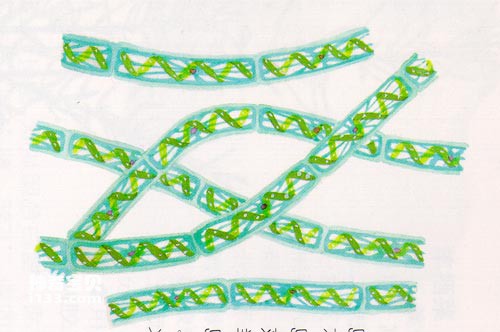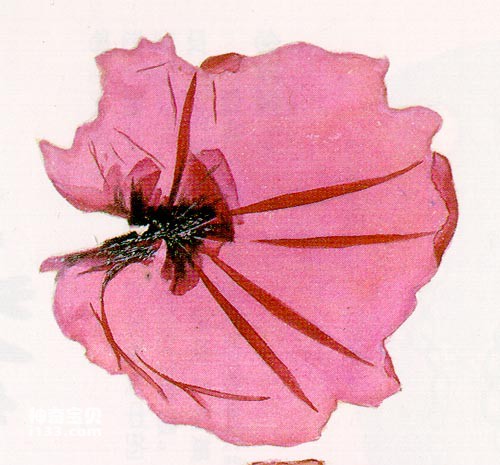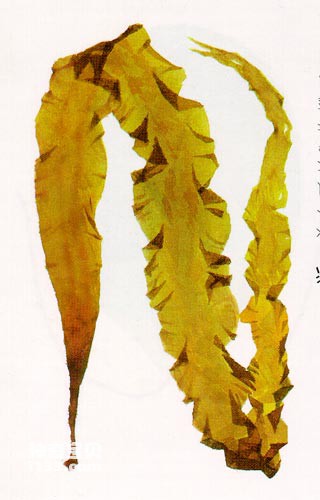Algae are the lower types of the plant kingdom. There are many kinds of them, with an estimated 18,000 species, belonging to green algae, diatoms, golden algae, red algae and brown algae. They are widely distributed in various waters on the earth.
Algae have a cell wall composed of cellulose, which is an important characteristic of them as plants.

Chlamydomonas
Primitive green algae such as Chlamydomonas are single-celled plants with eyespots and two flagella, capable of movement and reproduction with vegetative cells. During geological history, this kind of primitive green algae developed into more advanced green algae and other algae.
Green algae are widely distributed in freshwater waters with slow flow and shallow water depth. There are only a few species in the ocean. There are also some green algae living on the surface of soil clods and tree bark, and some are symbiotic with fungi to form lichens. Some green algae can even live in symbiosis with animals. For example, the green color of Hydra is due to its symbiosis with single-celled green algae.

Spirogyra
The morphological structures of green algae are diverse. Chlamydomonas, Protococcus, Chlorococcus, etc. are single-celled, Spirogyra, Scenedesmus, Chlorococcus, Hydrophyllum, Volvox, etc. are multi-cell groups, and higher green algae such as Ulva and Enteromorpha are Formed into sheets or tubes by groups of cells. Some green algae have multiple nuclei in one cell, such as siphonophores; some multicellular green algae cells have preliminary differentiation in appearance, such as charophytes with whorled branches.
There are many kinds of green algae, they are widely distributed and have a fast reproduction rate. They constitute the main primary producers in various waters on the earth. They use sunlight and inorganic nutrients in the water to synthesize carbon dioxide into organic matter through photosynthesis, playing an important role in the energy flow and material cycle of the entire aquatic ecosystem.
The photosynthetic pigments and structural proteins of photosynthetic lamellae of green algae are the same as those of higher plants, so scientists believe that higher plants originated from green algae.

seaweed
The color of chrysophytes and diatoms is yellow to golden brown. This is because although their chromophores contain chlorophyll a, they also contain β-carotene and phycoxanthin similar to lutein, and the latter two pigments The content is relatively large, so the color of the algae is yellowish.
There are quite a lot of species of golden algae, some are single cells, and some are not deeply differentiated cell groups. Some species have flagella, others do not.

Gelilium
The cell wall of diatoms contains silica, and the entire cell is shaped like a small box, usually composed of two shells covering each other. There are siliceous deposits on the shell pieces and various patterns are formed. There are many types of diatoms, but they are all single-celled phytoplankton or benthic plants. Diatoms have high reproduction rates and are highly photosynthetic, making them important producers in waters, especially in the ocean. There are significant seasonal differences in the reproduction of marine diatoms. In addition, because diatom shells contain a large amount of calcium silicate, silica and other siliceous substances that cannot be dissolved or digested by feeders, diatomaceous earth can be formed when the algal shells left on the seabed after their death accumulate in large quantities.

kelp
Some red algae are filamentous, flaky, and dendritic. Most of them live in the sea. Their cells have relatively strong cell walls, which contain a lot of cellulose. The cell groups are wrapped in colloid. There are chromophores in the cells of red algae, which contain chlorophyll a and b, as well as alpha carotene, lutein and a large amount of phycoerythrin. Different combinations of these pigments in different red algae make the algae appear purple, purple-red or red. Among them, phycoerythrin is unique to red algae. The seaweed we often eat and the Gelidium needed to make agar belong to red algae.
Brown algae are marine algae, with more than 1,500 species. Their individuals are all large or relatively large. For example, the length of kelp that humans often eat can generally grow to 2 to 4 meters. The macroalgae group is vividly called " "Forest in the sea", and the sea area where Sargassum grows constitutes the Sargasso Sea, and ships must avoid it when sailing.
Brown algae contain more lutein, which makes the algae appear brown, so brown algae is also called brown algae.
animal tags: Kelp Gelidium Porphyra Spirogyra Chlamydomonas
We created this article in conjunction with AI technology, then made sure it was fact-checked and edited by a Animals Top editor.